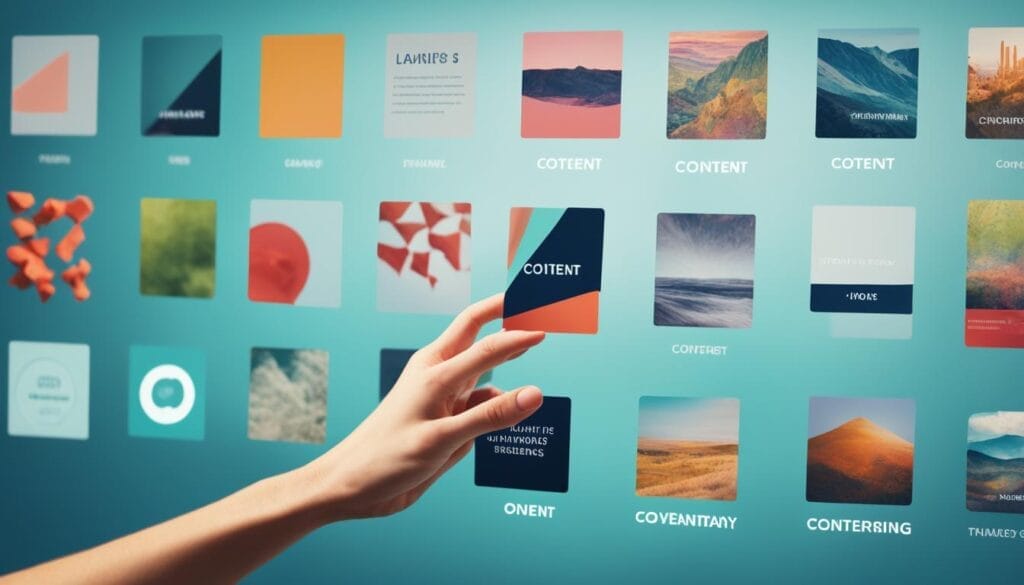Did you know that 60% of surveyed B2B marketers think content curation helps create engaging content?
Businesses are finding it more vital to use content curation. It helps them reach their audience better and share valuable info.
Content curation is about going through lots of online content. It picks out what’s best and most meaningful to share. This process is beneficial in many ways.
It makes your brand more trusted, saves money compared to making your own content, and it saves time. Plus, it helps you use the knowledge of other industry experts and keep up with the latest trends.
Key Takeaways
- Content curation is a valuable tool for businesses to produce engaging content.
- It involves sorting through a large amount of web content to find the best pieces.
- Curating content offers benefits such as increased credibility and cost-effectiveness.
- It saves time and allows businesses to leverage industry expertise.
- By curating content, businesses can stay on top of industry trends and deliver valuable information to their audience.
What is Content Curation?
Content curation is about finding and sharing the most meaningful web content. It’s like creating a collection of the best pieces on a topic. This helps people find quality content without searching everywhere.
This process is not just grabbing articles from the internet. It’s selecting the most valuable ones and showing them to others. This makes it different from simply gathering any content you come across.
Aggregation uses computers to gather content, but curation involves people choosing and describing the content they share.
Curation has many benefits. It helps you connect with content creators and build your expertise in an area. Plus, it enriches your website with high-quality material. This saves you time since you don’t have to create everything from zero.
Organised and Valuable
“Content curation is not about just collecting information, it’s about organising and presenting it in a valuable way.”
Content curation is not just about collecting articles or videos. It’s about picking the best ones and arranging them to offer real value. By choosing the top content, curators provide their audience with fresh perspectives and useful information.
Quality Control for Web Content
“Content curation is like being a quality control expert, ensuring that only the best content reaches the audience.”
There’s so much information online, and not all of it is trustworthy. With content curation, you act as a filter. You pick reliable and interesting content for your audience. This makes you a source they can depend on.
A Curator's Personal Touch
“Content curation is like adding your personal touch, giving curated content a human element.”
Content curation is more personal than automatic aggregation. Curators add their own comments or insights. This makes the content more engaging and develops a sense of trust with the readers. It shows you’re dedicated to finding not just good but the best content for them.
Examples of Where You Might Use Content Curation
Content curation fits different needs and audiences. Let’s look at ideas for using it:
1. Link Roundups
Link roundups, posted weekly, are a great example. This method gathers top resources on a theme and features them in one blog post. It helps your readers. Plus, it shows your deep knowledge of the topic. By curating great content, you become a trusted source in your field.
2. Curated Newsletters
Curated email newsletters are another smart use. They let you send handpicked content straight to your subscribers. You choose the best articles, news, and resources from your niche. This builds strong bonds with your readers. It also makes you a leading voice in your area.
3. Social Media Profiles
Curating content on social media boosts your online image. Mixing shared content and your own updates offers a diverse, engaging feed. This means more people are interested in what you post. The 5-3-2 Rule suggests 5 shared, 3 original, and 2 personal posts in every 10.

These strategies are just a start for using content curation in marketing. Whether through link roundups, newsletters, or social media posts, curating content keeps your audience interested and informed.
How to Curate Content as Efficiently and Expertly as Possible
Curating content well takes time, but several tools and methods can simplify the process. Start by exploring unique sources to find valuable content. Sites like BuzzSumo, Medium collections, and Google blog search are full of content you can use.
After discovering these sources, it’s key to thoroughly check what they offer. Dive into the content to select stories that will engage your audience. It’s about finding what resonates with them.
Keeping your curated content organised is also vital. Various approaches like using drafts, spreadsheets, or automation tools can help. Pick a method that fits your style to make everything easier to manage.
Now, it’s time to get your content out there. Selecting the best platforms and times to share can really boost your reach. Tools such as Buffer or Hootsuite can assist with this, making everything smoother.
Being a great content curator takes dedication, but it’s worth it. With the right tools and a good plan, you can regularly provide top-notch content to your audience.
Tips for Efficient Content Curation:
- Find unique places to discover valuable content using tools like BuzzSumo, Medium collections, SlideShare, and Google blog search.
- Read what you find thoroughly to identify the stories that stand out and align with your audience’s interests.
- Organise your curated content using methods like ongoing drafts, spreadsheets, bookmark systems, or automation tools.
- Share your curated content across the right channels and schedule your sharing strategically using tools like Buffer, Convertrr, Hootsuite, Mailchimp, or WordPress.
Why Content Curation is Important: Top 5 Benefits of Content Curation
Content curation gives marketers many advantages. It can improve their content plan and increase their online visibility. Let’s dive into the top 5 perks of content curation:
Increase Credibility
By sharing valuable content from trusted sources, you look like a leader. Curating showcases your know-how and eagerness to follow industry trends. This boosts how credible you seem to your readers.
More Cost-Effective
It’s cheaper to curate content than to make it all from scratch. Instead of spending big to create, you share content from other places. This saves time, effort, and helps you give valuable info to your audience affordably.
Faster than Generating Your Own Content
Curating content is quicker than making your own. Rather than spending loads of time writing, you can find and share existing pieces that suit your audience. This frees up time for other important tasks.
Leverage Industry Expertise
With content curation, you can share wisdom from industry leaders. Sharing their insights and expertise adds value for your audience. This allows you to provide diverse industry knowledge to your readers.
Stay on Top of Industry Trends
Staying updated and selecting key content helps you follow trends. By curating the latest insights and trends, you become a reliable source of industry news. This keeps your audience in the loop and positions your brand as a top expert.
Content curation offers marketers chances to boost credibility, cut costs, work efficiently, use outside expertise, and keep up with trends. By adding it to your strategy, you keep your audience hooked with top-notch, relevant content. This keeps them happy and well-informed.

How to Get Started with Content Curation: 3 Key Steps
Start your content curation journey with three important steps:
Choose Your Niche
Selecting your niche is a key first step in content curation. Choose a niche that is specific, attracting a targeted audience, but still broad enough for many content sources. A clearly defined niche will let you share content that really connects with your audience, showing your expertise in that area.
Define Your Goals
Setting clear goals and objectives for content curation is important. Your goals need to be SMART – specific, measurable, achievable, relevant, and time-bound. By setting these goals, your curation efforts will support your bigger marketing strategy. Goals could include things like boosting website traffic, getting more email subscribers, or becoming a thought leader in your field.
Find Your Sources
With your niche and goals set, it’s time to look for content sources. Use different tools and platforms to discover content related to your niche. Tools like Google Alerts, RSS feeds, and social media can be very helpful. But don’t forget to check the quality and freshness of the content to ensure you’re sharing the best with your audience. Avoid sources that are spammy or out-of-date as they can harm your credibility.
These steps – choosing your niche, setting your goals, and selecting your sources – help you start as a content curator. Always remember, content curation is about finding and sharing valuable content that benefits your audience. Start sharing and engaging with your content-loving audience today.

| Platform | Pros | Cons |
|---|---|---|
| Google Alerts | Automatically delivers relevant content to your inbox | May produce a large volume of content, requiring filtering |
| RSS feeds | Allows you to subscribe to specific websites and receive updates | Requires setup and management of RSS reader |
| Social media platforms | Provides access to real-time content from industry influencers | May require active monitoring to avoid information overload |
| Newsletters | Delivers curated content directly to your inbox | Can result in email overload if subscribed to too many |
| Blogs | Offers diverse perspectives and industry insights | Requires time and effort to discover reliable and valuable blogs |
| Online magazines | Provides curated content on specific topics | May have limited availability or require subscriptions |
To Sum Up...
Content curation is like art, where you find, organise, and share important content with people. Doing it well helps you connect with your audience, become more credible, and share helpful stuff.
When curating content, it’s vital to pick a topic you love, set clear goals, and find trustworthy sources. Arrange what you collect and make it unique with your thoughts. This way, you offer something special to those who see it.
Don’t forget to make your content easy to find online. Ask your audience to share and talk about what you’ve posted. And keep an eye on how well you’re doing to adjust your strategy if needed.
FAQ
What is content curation?
Content curation is about picking the best from lots of web content. It’s like sifting for gold.
How can content curation benefit businesses?
It makes a company look more trustworthy. Also, it’s cheaper and saves time than making all content from scratch. It helps use the best from industry experts and keep up with the latest.
What are some examples of where content curation can be used?
You can curate content in a blog, a newsletter, or on social media. Just choose what fits best for your audience.
How can I curate content efficiently and expertly?
Look for unique content sources. Read, pick your favourites, and organise them well. Then, share where it matters most.
What are the benefits of content curation?
It boosts credibility, saves money, and time. You also get to share leading industry insights and trends.
How can I get started with content curation?
Start with your niche and goals. Then, look for good content sources that match what you need.
Why is content curation important?
It’s key for sharing top-notch content. This boosts your credibility and saves time, while keeping you updated on what’s happening.
Source Links
READY TO TAKE BACK CONTROL?
- GET FOUND ONLINE
- GENERATE NEW LEADS
- WIN MORE SALES






